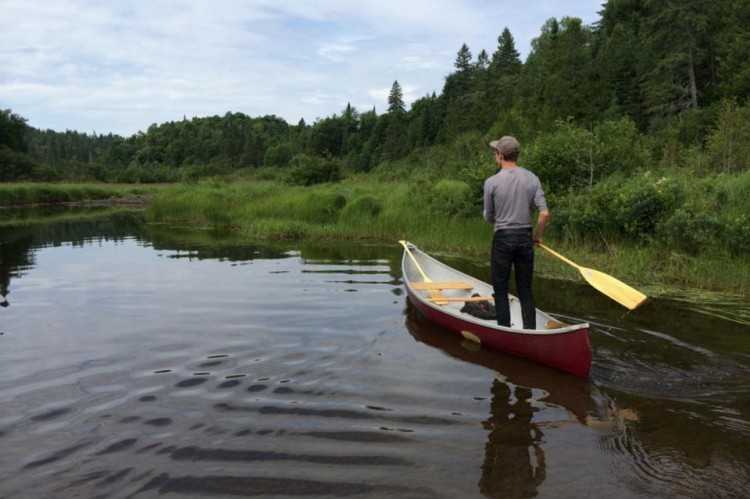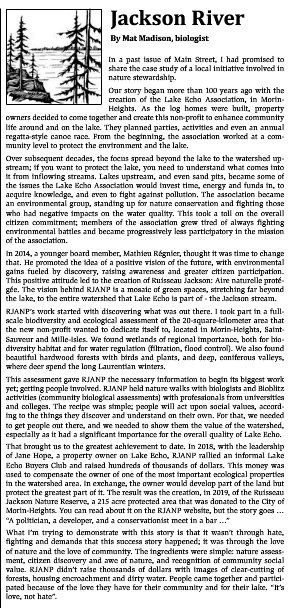JACKSON RIVER
By Mat Madison, biologist.
In a past issue of Main Street, I had promised to share the case study of a local initiative involved in nature stewardship.
Our story began more than 100 years ago with the creation of the Lake Echo Association, in Morin-Heights. As the log homes were built, property owners decided to come together and create this non-profit to enhance community life around and on the lake. They planned parties, activities and even an annual regatta-style canoe race. From the beginning, the association worked at a community level to protect the environment and the lake.
Over subsequent decades, the focus spread beyond the lake to the watershed upstream; if you want to protect the lake, you need to understand what comes into it from inflowing streams. Lakes upstream, and even sand pits, became some of the issues the Lake Echo Association would invest time, energy and funds in, to acquire knowledge, and even to fight against pollution. The association became an environmental group, standing up for nature conservation and fighting those who had negative impacts on the water quality. This took a toll on the overall citizen commitment; members of the association grew tired of always fighting environmental battles and became progressively less participatory in the mission of the association.
In 2014, a younger board member, Mathieu Régnier, thought it was time to change that. He promoted the idea of a positive vision of the future, with environmental gains fueled by discovery, raising awareness and greater citizen participation. This positive attitude led to the creation of Ruisseau Jackson: Aire naturelle protégée. The vision behind RJANP is a mosaic of green spaces, stretching far beyond the lake, to the entire watershed that Lake Echo is part of – the Jackson stream.
RJANP’s work started with discovering what was out there. I took part in a full-scale biodiversity and ecological assessment of the 20-square-kilometer area that the new non-profit wanted to dedicate itself to, located in Morin-Heights, Saint-Sauveur and Mille-Isles. We found wetlands of regional importance, both for biodiversity habitat and for water regulation (filtration, flood control). We also found beautiful hardwood forests with birds and plants, and deep, coniferous valleys, where deer spend the long Laurentian winters.
This assessment gave RJANP the necessary information to begin its biggest work yet; getting people involved. RJANP held nature walks with biologists and Bioblitz activities (community biological assessments) with professionals from universities and colleges. The recipe was simple; people will act upon social values, according to the things they discover and understand on their own. For that, we needed to get people out there, and we needed to show them the value of the watershed, especially as it had a significant importance for the overall quality of Lake Echo.
That brought us to the greatest achievement to date. In 2018, with the leadership of Jane Hope, a property owner on Lake Echo, RJANP rallied an informal Lake Echo Buyers Club and raised hundreds of thousands of dollars. This money was used to compensate the owner of one of the most important ecological properties in the watershed area. In exchange, the owner would develop part of the land but protect the greatest part of it. The result was the creation, in 2019, of the Ruisseau Jackson Nature Reserve, a 215 acre protected area that was donated to the City of Morin-Heights. You can read about it on the RJANP website, but the story goes … “A politician, a developer, and a conservationist meet in a bar …”
What I’m trying to demonstrate with this story is that it wasn’t through hate, fighting and demands that this success story happened; it was through the love of nature and the love of community. The ingredients were simple: nature assessment, citizen discovery and awe of nature, and recognition of community social value. RJANP didn’t raise thousands of dollars with images of clear-cutting of forests, housing encroachment and dirty water. People came together and participated because of the love they have for their community and for their lake. “It’s love, not hate”.
(Reproduced with permission from Main Street, June 2019 edition)



